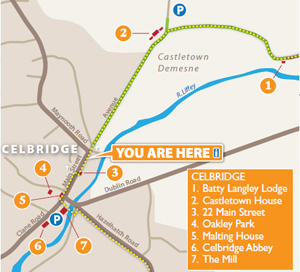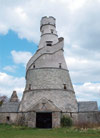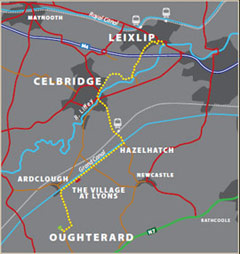
2. Arthur's Way, Celbridge
From Celbridge To Hazel Hatch

INTRODUCTION
Celbridge (in Irish Cill Droichid) means 'church by the bridge'. Originally, the Anglicised form would have been written as Kildrought, and this version of the name still survives in some parts of the town. There is a rich history in this area dating back 5,000 years, with many sites of interest. St. Patrick is linked with the town, and in the 12th and 13th centuries, the Normans developed Celbridge with the construction of castles, mills, houses and monastic sites.
SITES OF INTEREST
The Main Street developed into the thoroughfare we see today mainly from the early 1700s onwards. This was largely due to William 'Speaker' Conolly's purchase of the Castletown estate. The wealthy and successful politician, lawyer and landowner built the famous Palladian-style mansion on the estate between 1722 and 1729. Throughout the 1700s, many more houses sprang up along the approach to Castletown House.
One of these was 22 Main Street, which was occupied by Richard Guinness and his family. Richard was an estate manager for Archbishop Price, a position that probably included the brewing of beer. Both sons of Richard - Arthur and his younger brother, also Richard - would have grown up in Celbridge and it seems most likely they would have been introduced to the art of brewing at an early age. Indeed, it is likely that Arthur was born in 1725 in a malting house, here on the Main Street (in recent years, fittingly, a public house. Look out for a wall-mounted plaque which marks the property). It was partly a gift in his will from Archbishop Price of £100 each to Arthur and his father that helped start the brewing dynasty, though there is little doubt Arthur would not have known at the time how lasting a legacy he would leave when he invested the money into his first brewery.
There are numerous buildings of interest from this period, and many find themselves woven into the Guinness story in some fashion. Oakley Park (currently St. Raphael's hospital) was built in 1724 for Arthur Price when he became Church of Ireland Bishop of Meath. Celbridge Abbey was built in 1697, made famous as the meeting place of Jonathan Swift and Vanessa (Esther Van Homrigh), and later as the home of Irish parliamentarian, Henry Grattan.
The Manor Mills (or Celbridge Mill) was built by Louisa Conolly in 1785-8, and was reputedly the largest woollen mills in Ireland in the early 1800s. It has been restored recently. Local residents have developed an historical walking route which ties in with the Arthur Guinness story. An information board and leaflet will give you more details on how to enjoy a more in-depth tour of the town’s recent past.
A NOTE ON CASTLETOWN HOUSE
Arthur's Way loops through the beautifully managed grounds of Castletown House. You will be able to enjoy the facade of the house just as it was nearly 300 years ago. This is all down to the work of the Hon. Desmond Guinness, co-founder of the Irish Georgian Society (IGS) with his first wife, Mariga. Desmond Guinness is a direct descendent of Arthur Guinness, and in 1967, he stepped in to buy the house and grounds (120 acres) in order to save it from a large-scale housing development. Refurbishment work began through IGS and private funding.The house and demesne are now maintained by the Office of Public Works, allowing vital restoration work to continue. The house is open to the public and is a must-see for anyone with an interest in architectural heritage. For more information, please visit www.castletownhouse.ie
FURTHER ALONG THE ROUTE
Once you have enjoyed Celbridge town, you are ready to embark on the second leg of your journey. Pedestrians should take the footbridge over the Liffey and follow the signs to Hazelhatch. There is a short 3 km stretch of road which will bring you past Hazelhatch railway station and just beyond, access to the Grand Canal towpath, and a pleasant stretch that brings you directly to the Village at Lyons. Please be careful crossing the canal bridge at Hazelhatch. These old stone humpback bridges are quite narrow and it is difficult to see oncoming traffic.
Please note: the section in Castletown Demesne marked in GREEN is for walkers and cyclists only. This public space has several possible walking routes but cyclists should stay on the recommended route and always give way to pedestrians.

Arthurs Way
 RECOMMENDED ROUTE
RECOMMENDED ROUTE
POINTS OF INTEREST & DISTANCES
STAGE 1: Arthur Guinness Square, Leixlip
towards...
STAGE 2: Celbridge Main Street
towards...
STAGE 3: Hazelhatch Bridge
towards...
STAGE 4: Lyons Estate
towards Oughterard
![]()
LENGTH: 16km approx.
TIME: 3-3.5 hours walking; 1-1.5 hours cycling
GRADE: Easy. Generally flat with good surfaces. Inclines at Old Hill, Leixlip and
Ardclough. Mix of footpaths, tracks, roads and canal towpath. Suitable
for family groups. Normal outdoor footwear can be worn.
Arthur's Way is a waymarked linear route which can be enjoyed in either direction.
 Keep an eye out for the Arthur's Way information boards, fingerposts and marker posts to help keep you on track
Keep an eye out for the Arthur's Way information boards, fingerposts and marker posts to help keep you on track
PUBLIC TRANSPORT
To and from LEIXLIP:
Dublin Bus - all 66 routes
Irish Rail - Maynooth Suburban Line
To and from CELBRIDGE:
Dublin Bus - all 67 routes
Irish Rail - Portlaoise Line
www.dublinbus.ie
www.irishrail.ie
www.transportforireland.ie

Log on to the website to get more
information on the route, including
MAPS and LEAFLETS, and an AUDIO GUIDE.
www.ArthursWay.ie




